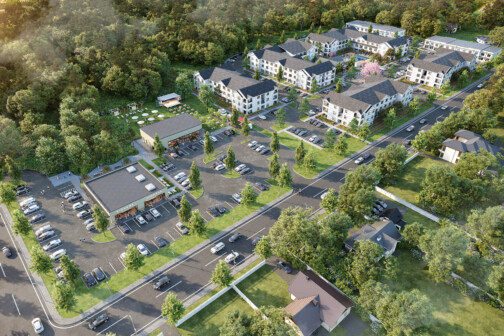Dallas’ new City Hall, a great ship of a building, rides at anchor in a smooth slip of a plaza on the ragged southern edge of downtown.
The only other structure in this entire scene able to stand up to the new monument in scale and quality is the Dallas Convention Center, but a direct, fair, and full confrontation between the two is thwarted by the intervening embarrassment of the Dallas Memorial Auditorium, which the Center joins. The new edifice makes an architectural statement so resoundingly authoritative that it shames the neighboring buildings, which have long stood around making only architectural remarks instead of statements.
The new City Hall is good news for Dallas and welcome company for the few lonely pieces of good architecture in the central city. City Hall Plaza is no less good news for Dallas, establishing as it does a formal urban space in the center of a city that had none. The scale of this place is magnificent, more appropriate to a land of big sky than are the stingy downtown streets. The modulation of this sweep of space is a tour de force: the three giant-carpet-tack flagpoles, the fountain with its pool, the great fallen mast of a concrete balustrade (all to be joined by the huge Henry Moore piece) are adroit in composition and impeccable in scale. Dallas finally has a proper place for pageantry.
As theater, Scene I is colossal and stupendous. Arrival at the plaza is clearly an event in itself, worthy of state occasions.
But Scene II is a downer: Since there is no curbside parking, one is obliged to drive on and park either in a used-car lot of a parking space to the south or within the bowels of the huge building itself. One is stuck with the suddenly excess baggage of his own automobile, having to move resentfully on. exactly at the moment when he needs, wants, yearns to be afoot on that plaza and be awe-struck, as in Piazza San Marco or Red Square or a dozen other places.
If one chooses to park underground, Scene III is worse still. One drives down a long ramp into an esthetic eclipse, a prison of a space with unsandblasted, un-painted, raw concrete columns, an expanse of equally unfinished concrete overhead, and lighting that, were it not so dim, would befit a factory. The spell has been temporarily, abruptly, cancelled.
This shock, this blackout, this insult, is built into the City Hall: it is part and parcel and will go on and on again and again breaking the spell of the design, like a diva singing flat every time at the same place in her aria.
Vitruvius insisted that “well-building” must combine “firmness, commodity, and delight.” Firmness and commodity are relatively easy to come by; it is delight in architecture that separates the adult persons from the juvenile persons. Great public architecture wants “delight.” Delight is good theater. Public architecture, to be great, must be good theater. The architect’s parking episode is not even bad theater. It is bad backstage. One is reminded of Tertullian’s metaphor of “a temple built over a sewer.”
What went wrong?
As it was conceived, the plaza would surely have been better bounded by streets, but is bounded instead by roads. (James Marston Fitch once pointed out the difference between a road and a street. He said that a road was a means of getting from one place to another, whereas a street was itself supposed to be a place.)
Dallas, unfortunately, hardly has any streets: instead it has roads. Our urban planners are working to create some streets in the city and the first of these are slowly evolving in the environment around the new City Hall.
The grand scheme of City Hall would make more sense in a pedestrian situation. Perhaps the architects were thinking of a walking city?
The great cities of the world are the walking cities. These cities, large or small, got their basic form while walking was still practiced. These are the places in which walking is a pleasure: They are the places to be. Dallas was built after the automobile had replaced walking. Like Los Angeles. Like Houston.
An essential difference between good walking architecture and good automobile architecture is that the former can completely ignore any responsibility to accommodate the automobile while the latter cannot. It is easier to create good walking architecture.
Once the program for an important building is established in favor of automobile architecture, it should be assumed that arrival by foot and by automobile should each be a first-class arrival or, put another way, that arrival by automobile should be no less first-class than arrival by foot.
It should be taken for granted that the beneficiaries of the building, those primarily for whom it is to be built, must benefit equally, regardless of their mode of arrival.
The City Hall was built primarily for the public citizens of Dallas, taxpayers, seekers of municipal largesse or fore-bearance, and visitors, sightseers, and tourists from elsewhere. It was not built for municipal employees, in the same sense that a museum is created primarily for museum goers and not for staff, and that a hotel is assembled for its guests and a church is raised up for its congregation.
In a democracy it is entirely fitting that public architecture should have, at the most, two ranks of access. One for the beneficiaries (the public) and one for staff, or employees. A more felicitous scheme would be to have a single high rank for all, with the minor exception of an entrance exclusively for the traffic of housekeeping. At any rate, the beneficiaries should all be guaranteed first-class passage into and out of public architecture.
Perhaps a solution for the City Hall would have been to create a formal upper parking level for the public (citizens, taxpayers, visitors, tourists, and sightseers) in a style harmonious with the building proper, and a lower parking level to be used as the service entrance (utility, garage, deliveries, staff parking).
We are apparently still in the paleo-technic era, as far as coping with the automobile is concerned. It is very late for ordinary architects to be waiting for someone else to work out answers to the automobile; for extraordinary architects, surely it is inexcusably late. Every now and then, one has to fight off the notion that the difference between ordinary architects and great architects is the rank of the realities that they ignore.
This cultural lag about the automobile has persisted now for a long time. Is there some valid excuse for it? It is, for example, considered fashionable in some circles not to have assimilated television as an important fact of twentieth-century life. The chic have held it at bay, the way the Victorian chic held the telephone at bay for so long; if you owned one at least you hid it and – for God’s sake – acted as if you were not sure it would work. The small-screen snobs of today keep television at bay, in the kitchen and the bedroom; they would not be caught dead with big-screen television. They forgive each other for allowing television in the first place as long as it is small-screen. The same kind of artistic snobbism persists against the automobile among many persons in the culture racket. To them, automobiles are, at best, only for transportation, the way food is endured for survival and sex is tolerated for reproduction (not necessarily by the same persons). In our culture, the automobile has been an important fact now for at least 60 years. During this time, our accommodation of this reality has more often than not been wrong, blown off course, deflected by the garden-club mentality of too many architects.
There seems also to have been some confusion at City Hall about above-ground versus below-ground architecture. Should everything above be grand and everything below be plain? This is an outdated syndrome. What logic is there in the simplistic application of a splurge-where-it-shows and scrimp-where-it-does-not policy, in which “where it shows” is translated as “above-ground” and “where it does not” is translated as “below-ground?” The inequitable allocation of funds (and thus, architectural rank) on a strict above-and-below-ground basis, when both are equally for the beneficiaries of the building, is unacceptably arbitrary.
Go underground. Take a look at the Metro systems around the world. The old ones seem to have been constructed under the concept, “It is all right to be ugly if it is underground.” The Moscow system, ironically, is a spectacular exception. Boston’s old subway system (now being updated) is threateningly grungy. So is New York’s. So is London’s old Underground. But the new Metros are another thing. Mexico City, Milan, and Montreal have created first-class space below ground. So has Paris in the new Metro stations, such as its Nation station with 84 escalators, yet. The new Washington Metro is an excellent example of the rejection of subterranean brutalism as either a technical or an economic necessity.
The new consensus seems clear: Underground does not have to be ugly, after all. Ugliness is no longer welcome, even underground.
Meanwhile, to see the new City Hall first-class, plan ahead. Hire a limousine, have your chauffeur or a friend drop you off, catch a city bus. Go in a taxi. Alight from the rear seat and get off on the scene. Scheme. Contrive. Plot. But, whatever you do, do not drive.
Related Articles

Commercial Real Estate
Former Mayor Tom Leppert: Let’s Get Back on Track, Dallas
The city has an opportunity to lead the charge in becoming a more connected and efficient America, writes the former public official and construction company CEO.
By Tom Leppert

Things to Do in Dallas
Things To Do in Dallas This Weekend
How to enjoy local arts, music, culture, food, fitness, and more all week long in Dallas.
By Bethany Erickson and Zoe Roberts

Commercial Real Estate
Why Mikial Onu is Pursuing Opportunities in Southern Dallas with The Adaline
This week marks the groundbreaking of the 12-acre mixed-use development by Onu Ventures near the intersection of Interstates 45 and 20.
By Audrey Henvey and The City UPSTAIRS, DOWNSTAIRS


